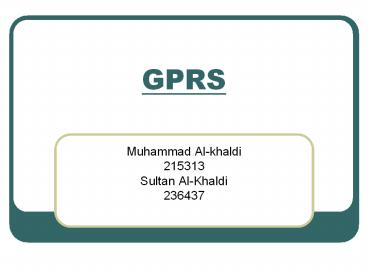GPRS PowerPoint PPT Presentation
1 / 25
Title: GPRS
1
GPRS
- Muhammad Al-khaldi
- 215313
- Sultan Al-Khaldi
- 236437
2
Outline
- What is GPRS?
- GPRS Handset Classes.
- Classes of GPRS services.
- Benefits of GPRS.
- GPRS Network Components.
- Simple GPRS Architecture.
- IP Addressing.
- Enhanced Data Rates for GSM Evolution.
- GSM Evolution for Data Access.
- Summary.
3
What is GPRS?
- GPRS stands for General Packet Radio Service.
- Allows data to be sent and received across a
mobile telephone network. - Step toward 3G.
- It is often referred to as 2.5G.
- GSM and GPRS different networks working in
parallel.
4
What is GPRS?
- GPRS combines mobile access with internet
protocol (IP). - It is packet based network technology.
- Send and receive data as text, graphics and
video. - GPRS is based on modulation technique known as
GMSK (Gaussian minimum-shift keying).
5
GPRS Handset Classes
- Class A
- Have 2 transceivers.
- allow them to send / receive data and voice at
the same time. - takes full advantage of GPRS and GSM.
- Class B
- can send / receive data or voice but not both at
the same time.
6
GPRS Handset Classes
- Class C
- Allows one means of connectivity.
- Like GPRS PCMCIA card in a laptop.
7
Classes of GPRS services
- traffic priority classification
- Precedence Class An application can be assigned
a Precedence Class 1, 2 or 3. If an application
has a higher precedence (1) than another (3) then
its traffic will be given a higher priority. - Delay Class Applications can request a delay
classes which guarantee an average and 95 delay
for 128 octet and 1024 octet packet size. There
are 4 classes, 1 being the fastest.
8
Classes of GPRS services
- Reliability class Applications can request
differing levels of reliability for its data
depending on its tolerance to data loss. - Throughput Class There are 2 distinctions in
class, peak and mean. Peak throughput class is
used mainly for bursty transmissions. Mean is the
average data transfer rate over a period of time
measured in octets per hour.
9
Benefits of GPRS
- Speed at around 56115 kbps
- Always on connectivity data can be sent or
received immediately as it is produced . - The system does not require establishing a
connection . - New and Better applications such as video
conferencing straight to your desktop or mobile
device.
10
Benefits of GPRS
- GSM operator Costs it allows GSM providers to
add value to their business at relatively small
costs. - Extremely efficient use of radio bandwidth this
is because it is packet based service.
11
GPRS Network Components
- GPRS is not a completely separate network from
GSM. - Packet Control Unit (PCU) used to control a
packet switched data. - Base Station Controller (BSC) it is part of GSM
network.
12
GPRS Network Components
- Serving GPRS Support Node (SGSN) it performs the
following tasks - Routing.
- Handover.
- IP address assignment.
- Verification and collection of billing data.
13
GPRS Network Components
- Gateway GPRS Support Node (GGSN) provide the
following - Works as a gateway.
- Works as a router.
- Works as a firewall.
- Confirms user details with RADIUS (Remote
Authentication Dial In User Service) servers for
security.
14
GPRS Network Components
- GPRS Tunneling Protocol (GTP) The main function
is to make connectivity between the SGSN GGSN - GTP sits on the top of TCP/IP
- responsible for the collection of mediation and
billing information. - Home Location Register (HLR) a database that
contains subscriber information
15
Simple GPRS Architecture
16
IP Addressing
- There are three different ways
- Fixed IP addressing IP to every handset (the 1st
way).
17
IP Addressing
- Dynamic IP addressing
- The 2nd way is by giving every GGSN an IP and
every handset belong to this domain. (like LAN) - The 3rd way (also dynamic) the IP is given by
RADIUS.( like dial up)
18
IP Addressing
19
Enhanced Data Rates for GSM Evolution
- EDGE provides Enhanced GPRS (EGPRS).
- Increased data rates with GSM compatibility.
- Still 200 KHz bands still TDMA.
- In addition to GMSK EDGE uses 8PSK.
- 8-PSK modulation 3 bits/symbol give 3X data rate.
20
Enhanced Data Rates for GSM Evolution
- EDGE can carry data speeds up to 384 kbps.
- It is anther step to 3G,it reffered as 2.75G.
- Shorter range (more sensitive to
noise/interference).
21
Enhanced Data Rates for GSM Evolution
- Introduces a new technology not found in GPRS,
Incremental Redundancy.This increases the
probability of correct decoding. - EDGE takes the cellular community one step closer
to UMTS.
22
GSM Evolution for Data Access
23
Summary
- GPRS is 2.5G.
- It have many advantages.
- the main components of GPRS is
- SGSN
- GGSN
- It have two types of IP addressing
- Fixed IP addressing
- Dynamic IP addressing.
24
Summary
- EDGE is 2.75G
- Carry data speeds up to 384 kbps.
- It uses both GMSK 8PSK.
- One step closer to UMTS.
25
Thank you
- Any Question

